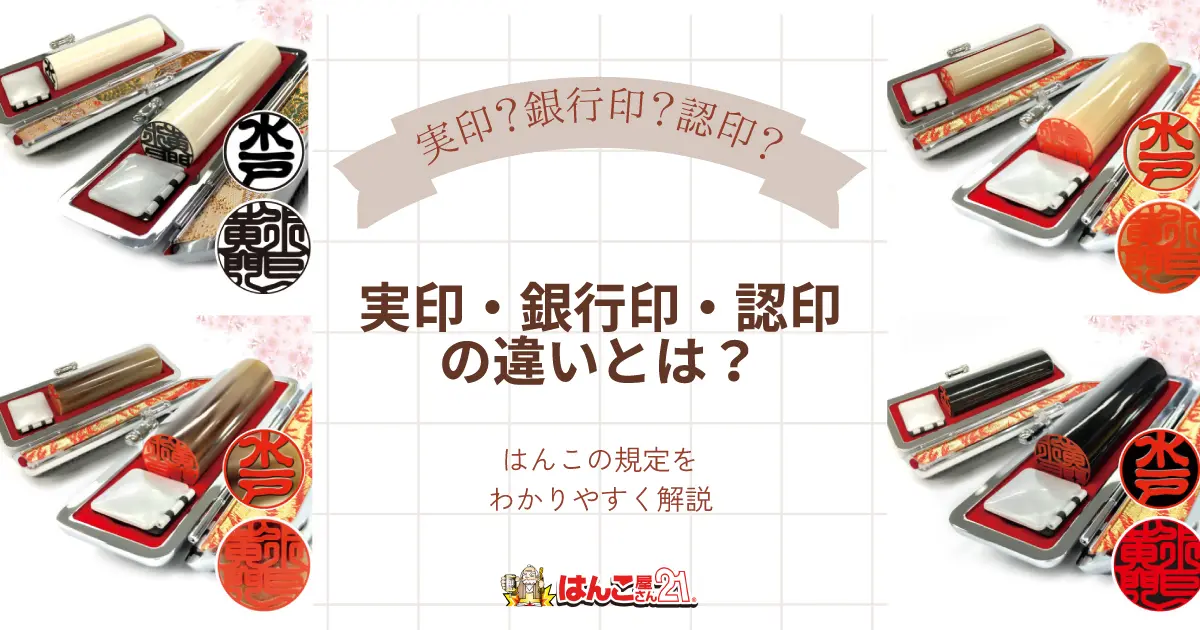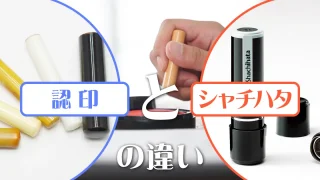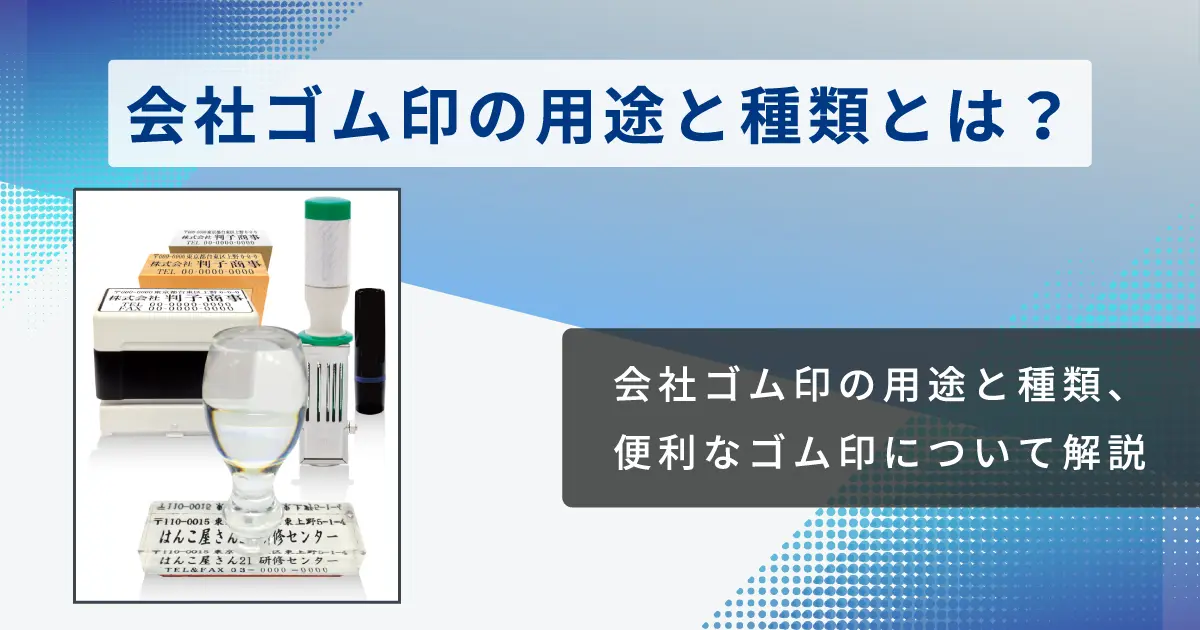There are three types of HANKO used by individuals: registered seals, bank seals, and registered seals. Are you able to properly use each in your daily life?
In this article, we will explain the differences between registered seals, bank seals, and registered seals in an easy-to-understand manner, which you may not be able to hear about. Be sure to learn about HANKO so that you do not use them incorrectly and your valuable HANKO and personal information are misused.
What is a registered seal?
We will introduce you to the most important registered seal among personal HANKO.
A HANKO HANKO
A registered HANKO that has been registered at the municipal office where you live. It is the only personal HANKO that is registered with a public institution, and by registering the HANKO, the HANKO can have a certain legal effect.
The government office where you have registered your registered seal will be able to issue a document called a HANKO registration certificate. A HANKO registration certificate is a document that must be submitted when signing an important contract, such as a real estate purchase or loan contract, as proof that the contract was entered into by the person's will.
size of registered seal
A registered seal is made by a professional HANKO company. Regarding the size of the registered seal to be created at that time, it is known that a size of 15 mm to 18 mm in diameter is easy to affix for men, and a size of 13.5 mm to 15 mm in diameter for women. Regulations vary by municipality, but as long as it fits within a square with sides of 10 mm or more and 25 mm or less, it can be registered as a registered HANKO.
Seal stamp (imprint)
Regarding the engraving (imprint) of a registered seal, in many cases both men and women engrave their full names. However, for women, the last name may change, so there are a certain number of unmarried women who create their names only using their first name. There are several typefaces, but Inso is the most commonly chosen typeface. Inso fonts are difficult to read, making them difficult to copy, effective in preventing counterfeiting, and considered to bring good luck.
Material for registered seal (stamp material)
Regarding the material for the registered seal, materials that are durable and easy to stamp are suitable. Since it is registered at the government office, materials that are easily damaged will become unusable immediately, and HANKO that get scratched when stamped to check against the HANKO certificate will be unusable. In addition to materials such as ivory and buffalo horn that have been popular since ancient times, titanium has become popular in recent years. It is a popular stamp material for both men and women because it is durable, easy to care for, and has few metal allergies.
Purpose of use of registered seal
A registered seal is used for important contracts. Specifically, there are cases where written contracts are stipulated by law, such as home purchase and sale transactions, mortgage contracts, various insurance contracts, and inheritance of inheritance. By not only stamping the contract but also submitting it along with the HANKO registration certificate, you can prove that the contract was made by the individual himself/herself.
When changing the registered seal
If you wish to change your registered seal due to damage, etc., please go to the government office where you registered HANKO to have it changed. We will carry out the procedures for abolishing the HANKO and registering a new HANKO. The items required for the procedure are a HANKO registration card, the HANKO to be discarded, a new HANKO, and identity verification documents. Fill out the necessary information on the HANKO registration abolition application form and HANKO registration application form available at the counter and submit.
If you lose your registered seal
If you lose your registered seal, there is a risk that it may be misused, so be sure to take action as soon as you notice. The first thing you should do is report the loss to the local government office. This procedure prevents the issuance of HANKO certificates to prevent the risk of misuse. After reporting the loss to the police and taking first aid measures, use the registered seal that was lost to notify the relevant parties that you have contracted with of the loss. If necessary, please create a new registered seal and re-register.
What is a bank seal?
We will introduce you to the bank seal required when opening a bank account.
HANKO to be submitted to the bank
As the name suggests, a bank seal is a HANKO used to notify the bank. It is used when opening an account and making transfers and withdrawals at a counter. Although the frequency of use is decreasing due to the spread of online banking, there are still many opportunities to use it, such as when registering a debit account when applying for a credit card.
bank stamp size
There are no special regulations for bank seals, but some financial institutions may have conditions. Specialized HANKO companies offer bank stamps of 12.0 mm to 13.5 mm, so be sure to choose one that does not deviate significantly from the recommended size.
bank seal stamp
When it comes to bank stamps, surnames are often engraved, but children's names may also be engraved. Generally, either the surname or first name is engraved.
Typefaces that are difficult to read are often chosen, such as inso and seal typefaces, which have broken letters. Choosing a typeface that is difficult to read helps prevent forgery and fraud.
Bank seal material
Materials that are durable and have a luxurious appearance are preferred as materials for bank seals. The standard seal is a natural black buffalo HANKO, and the jet-black natural material has a luxurious appearance and is soft to the touch, making it easy to stamp. Titanium is also recommended as it is durable, as is the case with real seals.
Usage of bank seal
A bank seal is affixed during procedures such as opening an account at a counter. Although some banks do not require HANKO registration, many financial institutions still require bank seal registration.
When changing the bank seal
If you wish to change your bank seal, please complete the procedure at the bank where HANKO is registered. Please bring your currently registered HANKO, the new HANKO you wish to change, your identity verification documents, your bankbook, etc.
If you lose your bank seal
If you lose your bank seal, just like with registered seals, be sure to take action as soon as you notice. Contact your bank to inform them of the loss of your bank seal and request them to immediately stop the procedures using your passbook and bank seal. After that, register your new HANKO again.
What is a registered seal?
Next, we will introduce the seals that are most often stamped on a daily basis.
HANKO that has not been registered
A personal seal is a personal HANKO that is used on a daily basis without having to register at a government office or bank. A registered seal is registered at a government office, and a bank seal is registered at a bank, but a registered seal is a HANKO that can be used without being registered with any institution. It can be said to be the most frequently used daily HANKO among personal HANKO .
size of seal
Since the seal is not registered with any institution, there is no set size. However, in order to distinguish it from other personal HANKO, there is a size that is commonly used. A size between 10.5mm and 12mm that is easy to hold and press has been selected. There is no difference between men and women in terms of size.
stamp of seal
The font for the mitshu tends to be one that is easy to read, such as koin font or kaisho font. The reason for this is that the purpose of the seal is to clearly indicate who has verified it. If a third party does not know who verified it, it cannot fulfill its role as a certified seal.
Seal material
Inexpensive yet durable materials are preferred for the seal. Typical materials used for the seal include Japanese cypress with its beautiful wood grain, black water buffalo horn dyed jet black, and acrylic that can be finished with a design that does not overlap with other people.
Purpose of use of seal
Since the seal is a HANKO that is used on a daily basis, it can be used for a wide variety of purposes. Typical examples include marriage registration, birth registration, application for issuance of resident card, pension and national health insurance procedures, and stamping of various documents submitted to the company (employment contracts, etc.).
Changing your seal or losing it
If you want to change your HANKO due to damage, etc., or if you have lost your seal, there is no need for you to do anything in particular, as there is no registration procedure for your seal at any institution. There is no problem even if you perform the procedures introduced above with a different seal. You can ask a professional HANKO company to create an original seal again, or if you need it urgently, you can purchase a simple seal at a 100 yen shop. Also, there is no problem in owning multiple seals, so it is recommended that you use them separately for home and office use.
Can Shachihata be used as a seal?
Shachihata is a HANKO that is used on a daily basis, but please note that there are some cases where it cannot be used as a seal. Shachihata and other penetrating seals have rubber stamp surfaces and are easily deformed, so there are many cases where Shachihata is not acceptable for the government procedures introduced in the usage of the above-mentioned seal. Shachihata is fine if you are doing office work to confirm things at work or receiving mail.
Differences from HANKO used at companies
HANKO used by companies include registered seals, registered seals, and bank seals. Let's take a look at the differences between personal seals and personal HANKO.
registered seal
Individual registered seals are registered at the municipal office, but in the case of corporations, the representative seal is registered at the Legal Affairs Bureau. Please note that the place where the HANKO registration certificate is issued will be different. Also, while an individual's registered seal has their name engraved on it, a corporation's registered seal has their company name engraved on the outside of the double circle and their title on the inside.
bank seal
Both personal bank seals and corporate bank seals are used for registration with financial institutions. However, while an individual's bank seal stamps the name, a corporate bank stamp stamps the company name on the outside (palindrome) of the double circle, and the bank's seal etc. on the inside (inside the circle).
Seal
For personal seals, the last name or first name is engraved inside a round seal, but for corporate seals, a square seal is used with the company name engraved inside a square frame.
Points to note when creating a HANKO
Finally, we will explain the points to keep in mind when creating a HANKO.
Do not use as a HANKO
If a registered seal and a bank seal are used together, or a bank seal and a registered seal, management becomes unclear and the risk of forgery or misuse increases. In order to use HANKO for optimal purposes, let's create each HANKO according to its purpose.
keep separate
If you keep them in the same place, you may end up using them for the wrong purpose. Store the HANKO you have created in separate locations and manage them to avoid mixing them up. Especially in the case of a corporation, it is necessary to set up a system for careful management by keeping records of users.
summary
We introduced the differences between registered seals, bank seals, and registered seals. In everyday life, you may not have many opportunities to consciously use different HANKO, but when signing an important contract, it is necessary to prepare the appropriate HANKO. Please review this article again and use it as a reference for how to properly use HANKO.
 日本語
日本語 English
English 简体中文
简体中文 繁體中文
繁體中文 한국어
한국어 ไทย
ไทย Tiếng Việt
Tiếng Việt Indonesia
Indonesia Français
Français Español
Español Português
Português






